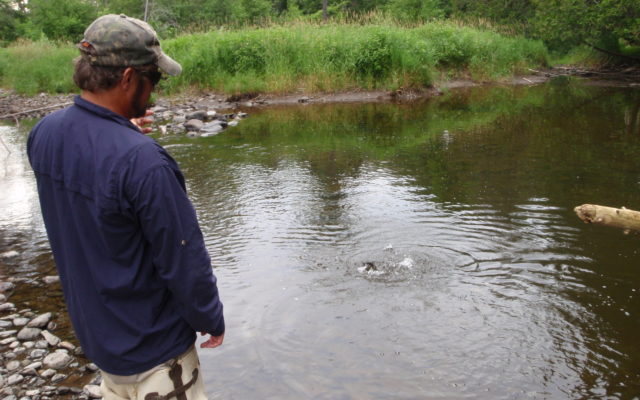Among my top three favorite fishing outings here in Northern Maine will always be wading regional brooks and casting a dry fly. There are dozens of small streams within a 15-minute drive of most Aroostook towns and villages. These moderate-sized waterways vary from 10 feet to 10 yards wide, much narrower and less deep than most rivers and perfect for anglers who prefer hip boots or just sneakers and dungarees on really warm days.
Fly casting action on local rivers and large streams tends to decline as day time temperatures rise. Water warms and levels recede as the sun beats down and water oxygen levels decline, leading to lethargic trout and slow fishing. Most brooks and creeks wander through forest and brush-lined farmland, so often enjoy leafy shrouding and respite from the direct glare of summer sunlight. Spring holes, ledge seeps and tiny creek inlets also help keep brooks at even levels and lower temperatures than larger waterways.
These wandering rural brooks attract more and larger trout during July and August as fish move into these tributaries from warming, larger rivers. While cooler mornings and evenings and overcast or rainy days often provide faster dry fly action, steady surface takes can still be enjoyed even at mid day. Often fly size, color and pattern choices for various times of day make a vast difference in how frequent trout can be teased to rise and strike. Larger native brookies, 12 to 16 inches in length, didn’t get that size by being stupid or easily hoodwinked by fake insects.
For dawn, dusk and dreary, cloudy day summer outings, I have a half dozen “go to” dry flies in sizes 14 and 16 that work about 75 percent of the time. I do have a scant number of size 18 patterns for really finicky fish, but rarely need them. That is a good thing since threading the leader through the miniscule eye is a chore. I swear the flies had larger eye holes when I was in my 20s. I refuse to even own size 20 or 22 dry flies.
It’s a toss up every time whether I’ll try a mosquito, gray slim Jim or a Henryville special first. I like gray and a nice thick hackle for a high, jaunty float. The trout seem to favor these patterns as well. A dab of bright color often perks up the interest and feeding fervor too, so a Royal Coachman fits the bill. I actually prefer a Royal Trude, with the only difference being the wing is made of white calf tail rather than white duck feather. It is a more visible, longer floating version.

Ron Robichaud of Portland drives to Aroostook two or three times a summer for a weekend of dry fly fishing regional small brooks. Even at mid afternoon on a sunny day, the fishing is productive with the right pattern. (Contributed/Bill Graves)
When light is at a premium early and late in the day, I try to give myself a little advantage in tracking my dry fly float by using a lighter colored, more visible pattern. If you can’t see your fly well, it’s likely that the hook set may be missed when a trout rises. A blue wing olive dun, a light Cahill and a light Hendrickson offer excellent options for your eyesight and a brook trout’s attention.
For mid-day casting when the sun and temperature are elevated, I turn to a very different floating fly. What could be more authentic in farm and forest areas than a terrestrial? Real bugs fall into brooks all the time from bushes, shoreline grass and overhanging trees. There are beetles, spiders, ants, caterpillars, crickets and my favorite to cast, an imitation fly pattern of the grasshopper. There are dozens of ’hopper patterns of various colors and a choice of foam, wool or chenille bodies.
The particular grasshopper fly I’ve caught the most and largest trout from some of Aroostook’s smaller brooks is called Joe’s hopper. Tied on a size 6 to-12, 2X dry fly hook, it’s got a tail of red hackle barbules, a body of yellow poly yarn with a loop extending over the tail and ribbed with brown hackle trimmed short. Matched sections of mottled turkey wing quill coated with vinyl cement overlapping the body really make this pattern effective. Finish it off with a thick hackle of mixed brown and grizzly. It floats high and pretty.
I also like a grasshopper fly with a green or orange foam body and the same wings and hackle. Use a bit of rod-tip action to make the fly wiggle through the water, just like a real ‘hopper that fell from the bank side grass might struggle. Cast and drop the ‘hopper fly near shore and work it toward midstream to coax trout to strike. Use the same tactic for beetles, caterpillars, bees, inchworms and lady bugs. These terrestrials will catch fish every day regardless of summer weather.
Visit a small brook near your home town this month or next and carry along a selection of the dry flies and terrestrials I’ve mentioned and there are sure to be brookies for breakfast. Local waterways are actually flowing pretty well for this time of year, while most other outdoor sportsmen aren’t happy with the constant rainstorms, fishermen are taking full advantage of the higher, cooler stream flow. Plan on a pre- or post-work outing soon, or even take a long lunch with your fly rod. The trout are taking terrestrials now.
- Tom Tardiff of Robinson only has a 10-minute drive to Whitney Brook in Bridgewater to toss out a dry fly to trout schooled up in deep holes and spring inlets. Here he plays one of several fat brookies caught and released on an afternoon outing. (Contributed/Bill Graves)








